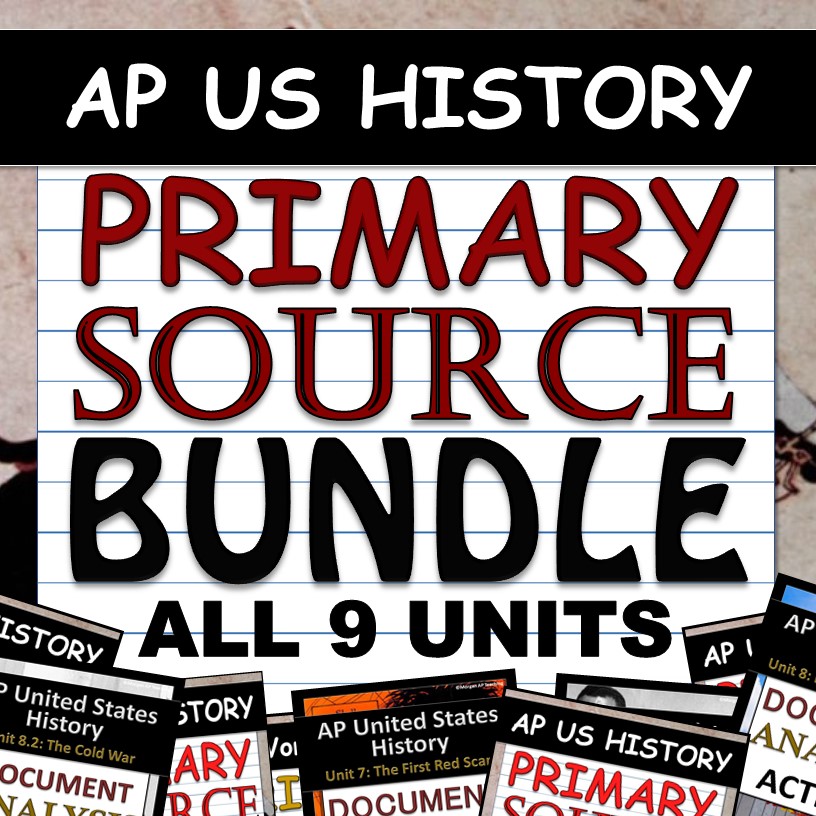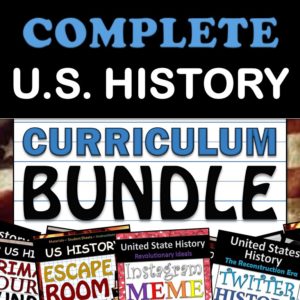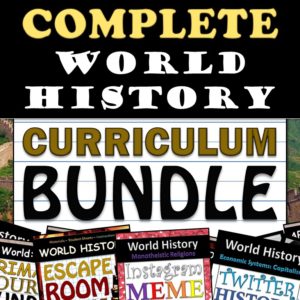
Click the Image Below to Preview!
Other Popular Products
AP United States History:
Document Analysis Bundle!
APUSH Primary Source Bundle contains MORE THAN 110 PRIMARY SOURCE ACTIVITIES that cover ALL UNITS (1.1-9.6)! Google Drive access! Activities provide practice for AP Historical Thinking Skills 1.A, 2.A, 2.B, 2.C, 3.A, 3.C, 5.A, 5.B, 6.B, and 6.C! These are the historical skill activities I use with my students to achieve passing rates of over 90%!
I have added 96 NEW primary source activities to my original 16 that provide differentiated perspectives across all learning objectives for APUSH.
The activities can be used as emergency sub print-and-go activities, in class for group or individual work, or assigned as homework for AP Test practice.
Bundle includes the following:
- An overview on how to use the resources
- Group and individual activity options!
- Answer keys to function as discussion guides
- Google Drive Access
- Lifelong access to all future updates!
- See the covered Unit Guide Learning Objectives for each below:
The 96 NEW Primary Source Activities
Period 1: 1491–1607
- 1.1 Contextualizing Period 1
- 1.2 Native American Societies Before European Contact
- 1.3 European Exploration in the Americas
- 1.4 Columbian Exchange, Spanish Exploration, and Conquest
- 1.5 Labor, Slavery, and Caste in the Spanish Colonial System
- 1.6 Cultural Interactions Between Europeans, Native Americans, and Africans
Period 2: 1607–1754
- 2.1 Contextualizing Period 2
- 2.2 European Colonization
- 2.3 The Regions of British Colonies
- 2.4 Transatlantic Trade
- 2.5 Interactions Between American Indians and Europeans
- 2.6 Slavery in the British Colonies
- 2.7 Colonial Society and Culture
Period 3: 1754–1800
- 3.1 Contextualizing Period 3
- 3.2 The Seven Years’ War (The French and Indian War)
- 3.3 Taxation Without Representation
- 3.4 Philosophical Foundations of the American Revolution
- 3.5 The American Revolution
- 3.6 The Influence of Revolutionary Ideals
- 3.7 The Articles of Confederation
- 3.8 The Constitutional Convention and Debates over Ratification
- 3.9 The Constitution
- 3.10 Shaping a New Republic
- 3.11 Developing an American Identity
- 3.12 Movement in the Early Republic
Period 4: 1800–1848
- 4.1 Contextualizing Period 4
- 4.2 The Rise of Political Parties and the Era of Jefferson
- 4.3 Politics and Regional Interests
- 4.4 America on the World Stage
- 4.5 Market Revolution: Industrialization
- 4.6 Market Revolution: Society and Culture
- 4.7 Expanding Democracy
- 4.8 Jackson and Federal Power
- 4.9 The Development of an American Culture
- 4.10 The Second Great Awakening
- 4.11 An Age of Reform
- 4.12 African Americans in the Early Republic
- 4.13 The Society of the South in the Early Republic
Period 5: 1844–1877
- 5.1 Contextualizing Period 5
- 5.2 Manifest Destiny
- 5.3 The Mexican–American War
- 5.4 The Compromise of 1850
- 5.5 Sectional Conflict: Regional Differences
- 5.6 Failure of Compromise
- 5.7 Election of 1860 and Secession
- 5.8 Military Conflict in the Civil War
- 5.9 Government Policies During the Civil War
- 5.10 Reconstruction
- 5.11 Failure of Reconstruction
Period 6: 1865–1898
- 6.1 Contextualizing Period 6
- 6.2 Westward Expansion: Economic Development
- 6.3 Westward Expansion: Social and Cultural Development
- 6.4 The “New South”
- 6.5 Technological Innovation
- 6.6 The Rise of Industrial Capitalism
- 6.7 Labor in the Gilded Age
- 6.8 Immigration and Migration in the Gilded Age
- 6.9 Responses to Immigration in the Gilded Age
- 6.10 Development of the Middle Class
- 6.11 Reform in the Gilded Age
- 6.12 Controversies over the Role of Government in the Gilded Age
- 6.13 Politics in the Gilded Age
Period 7: 1890–1945
- 7.1 Contextualizing Period 7
- 7.2 Imperialism: Debates
- 7.3 The Spanish–American War
- 7.4 The Progressives
- 7.5 World War I: Military and Diplomacy
- 7.6 World War I: Home Front
- 7.7 1920s: Innovations in Communication and Technology
- 7.8 1920s: Cultural and Political Controversies
- 7.9 The Great Depression
- 7.10 The New Deal
- 7.11 Interwar Foreign Policy
- 7.12 World War II: Mobilization
- 7.13 World War II: Military
- 7.14 Postwar Diplomacy
Period 8: 1945–1980
- 8.1 Contextualizing Period 8
- 8.2 The Cold War from 1945 to 1980
- 8.3 The Red Scare
- 8.4 Economy after 1945
- 8.5 Culture after 1945
- 8.6 Early Steps in the Civil Rights Movement (1940s and 1950s)
- 8.7 America as a World Power
- 8.8 The Vietnam War
- 8.9 The Great Society
- 8.10 The African American Civil Rights Movement (1960s)
- 8.11 The Civil Rights Movement Expands
- 8.12 Youth Culture of the 1960s
- 8.13 The Environment and Natural Resources from 1968 to 1980
- 8.14 Society in Transition
Period 9: 1980–Present
- 9.1 Contextualizing Period 9
- 9.2 Reagan and Conservatism
- 9.3 The End of the Cold War
- 9.4 A Changing Economy
- 9.5 Migration and Immigration in the 1990s and 2000s
- 9.6 Challenges of the 21st Century
The Original 16 Activities
Period 1-3 (Units 1-3)
- Unit Guide standard 1.6
- Unit Guide standard 2.7
- Unit Guide standard 3.6
- Unit Guide standards 3.8-3.10
Period 4-5 (Units 4-5)
- Unit Guide standards 4.5 & 4.6
- Unit Guide standards 4.9 & 4.10
- Unit Guide standards 5.3, 5.4, & 5.9
- Unit Guide standards 5.6 & 5.7
Period 6-7 (Units 6-7)
- Unit Guide standard 6.10
- Unit Guide standard 6.12
- Unit Guide standard 7.4
- Unit Guide standard 7.6
Period 8-9 (Units 8-9)
- Unit Guide standard 8.1
- Unit Guide standard 8.2
- Unit Guide standard 8.7
- Unit Guide standards 9.3



